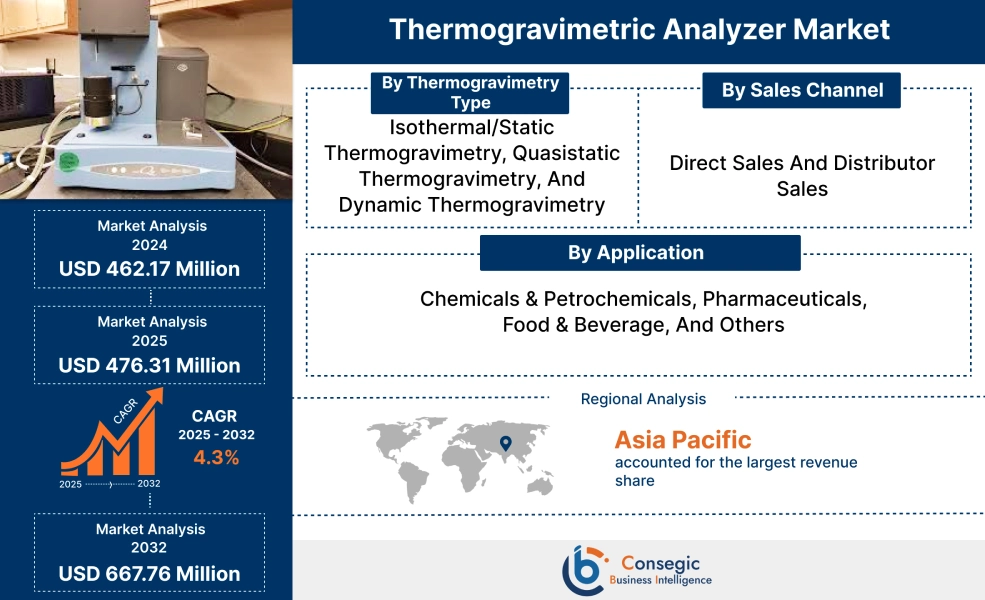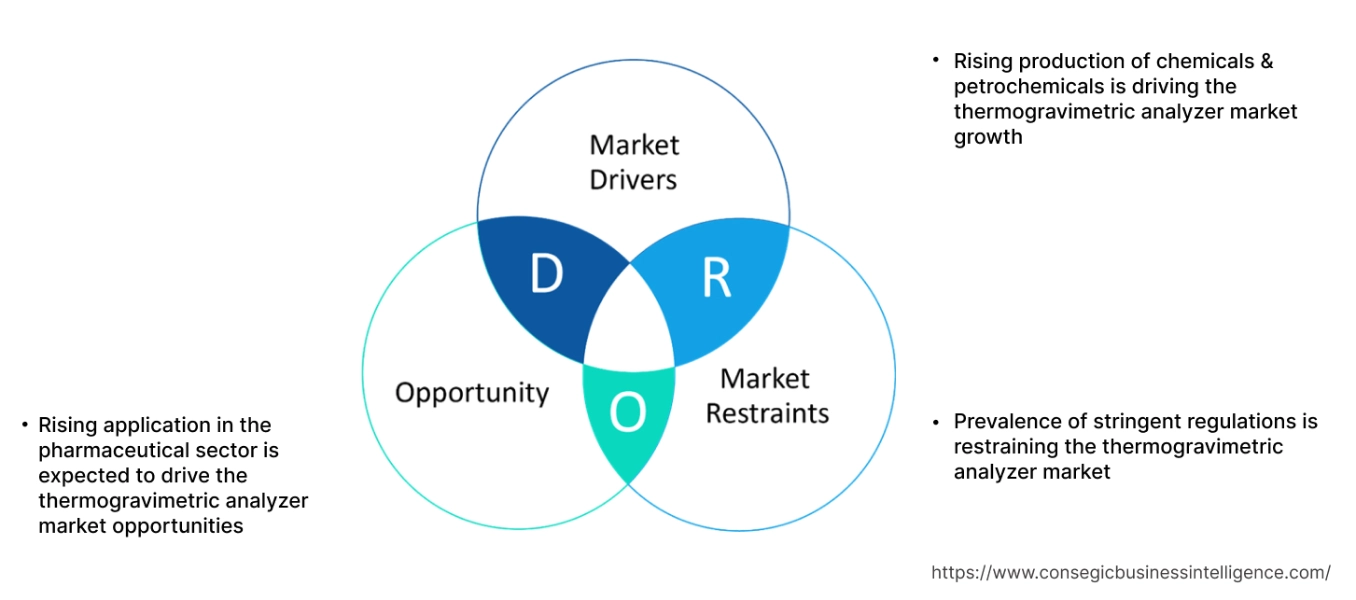Thermogravimetric Analyzer Market Size:
Thermogravimetric Analyzer Market size is estimated to reach over USD 667.76 Million by 2032 from a value of USD 462.17 Million in 2024 and is projected to grow by USD 476.31 Million in 2025, growing at a CAGR of 4.3% from 2025 to 2032.
Thermogravimetric Analyzer Market Scope & Overview:
Thermogravimetric analyzer (TGA) refers to an instrument that is used for measuring the variation in mass of a sample as it is held, heated, or cooled at a constant temperature within a specified atmosphere. They are often used by scientists, researchers, and engineers across several industries to facilitate precise measurement of thermal effects, including oxidation, evaporation, decomposition, and absorption among others. Additionally, thermogravimetric analyzing instruments are used in various industries including chemicals & petrochemicals, pharmaceuticals, food & beverage, and others.
How is AI Impacting the Thermogravimetric Analyzer Market?
AI is revolutionizing the thermogravimetric analyzer (TGA) market by enhancing data analysis, automation, and predictive capabilities. TGA equipment, which measures weight changes as a material is heated, generates complex data. AI, specifically machine learning and artificial neural networks, can now process this data to identify patterns and predict material behavior with greater speed and accuracy than traditional methods. This allows for more sophisticated kinetic modeling and a deeper understanding of thermal properties. By automating data interpretation and reducing manual intervention, AI-integrated TGA systems free up researchers' time and improve laboratory efficiency, driving demand and market growth in industries like polymers, pharmaceuticals, and material science.
Thermogravimetric Analyzer Market Dynamics - (DRO) :
Key Drivers:
Rising production of chemicals & petrochemicals is driving the thermogravimetric analyzer market growth
Thermogravimetric analyzer plays a vital role in the chemicals & petrochemicals sector for characterization and analysis of materials. They provide information related to the thermal stability, composition, and absorption of materials by measuring changes in weight as a function of temperature or time under controlled atmospheres. Moreover, thermogravimetric analyzing instruments are primarily used in the chemicals & petrochemicals sector for the study of materials, such as thermoplastics, elastomers, thermosets, composites, fibers, paints & coatings, plastic films, and fuels among others.
- For instance, according to the German Chemical Industry Association, the total production of the chemical sector in Germany was valued at approximately USD 199.76 billion in 2022, among which fine specialty products accounted for 25% of the total chemical production value, followed by polymers with 20%, petrochemicals with 16%, and inorganic base chemicals with 12% among others.
Thus, the rising production of chemicals & petrochemicals is driving the thermogravimetric analyzer market size.
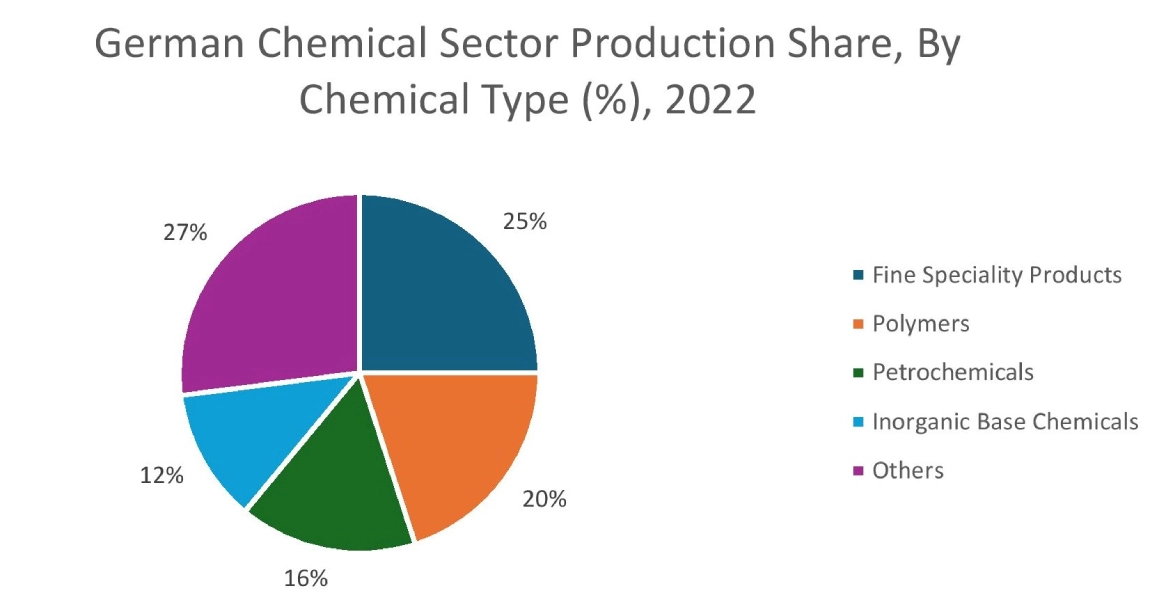
Key Restraints:
Prevalence of stringent regulations is restraining the thermogravimetric analyzer market
The manufacturers of thermogravimetric analyzers have to comply with numerous stringent standards such as ISO (International Organization for Standardization) Standard - ISO 9001, ISO 11358, ASTM (American Society for Testing and Materials) standard, and others, which is a primary factor constraining the market growth.
For instance, the ISO 9001 standard specifies particular requirements for a quality management system. Thermogravimetric analyzing instrument manufacturers must comply with the ISO standard to demonstrate the ability to consistently provide products and services that meet regulatory and customer requirements. Additionally, ISO 11358 standard specifies guidelines and conditions for the analysis of polymers by utilizing thermogravimetric techniques.
Further, ASTM E 914 standard is applicable to the evaluation of temperature scale for thermogravimetry. Therefore, the prevalence of the aforementioned regulations and standards associated with thermogravimetric analyzing instruments is hindering the thermogravimetric analyzer market expansion.
Future Opportunities :
Rising application in the pharmaceutical sector is expected to drive the thermogravimetric analyzer market opportunities
Thermogravimetric analyzers are often used in the pharmaceutical sector for applications involving drug development and quality control. Thermogravimetric analyzing instruments are used to assess the thermal stability of APIs (active pharmaceutical ingredients) and finished dosage forms under accelerated conditions. Moreover, thermogravimetric analyzing instruments are also utilized for quality control in pharmaceutical manufacturing to ensure final pharmaceutical products meet specified standards.
- For instance, according to the European Federation of Pharmaceutical Industries and Associations (EFPIA), the total production of the pharmaceutical sector in Europe was valued at USD 430.42 billion in 2023, witnessing an increase of 7.3% in comparison to USD 400.95 billion in 2022.
Thus, the rising pharmaceutical production is anticipated to boost the thermogravimetric analyzer market opportunities during the forecast period.
Thermogravimetric Analyzer Market Segmental Analysis :
By Thermogravimetry Type:
Based on thermogravimetry type, the market is segmented into isothermal/static thermogravimetry, quasistatic thermogravimetry, and dynamic thermogravimetry.
Trends in the thermogravimetry type:
- Increasing trend towards the adoption of dynamic thermogravimetry for applications including material characterization, pharmaceutical, environmental studies, and others.
- Significant adoption of isothermal/static thermogravimetry for studying long-term stability or slow thermal processes is driving the market.
The dynamic thermogravimetry segment accounted for the largest revenue share in the total thermogravimetric analyzer market share in 2024, and it is anticipated to register the fastest CAGR growth during the forecast period.
- In dynamic thermogravimetry, a specific sample is heated in an environment where the temperature is altered in a linear manner.
- Similarly, in dynamic thermogravimetry, the temperature continues to increase over time as mass is recorded. This enables simultaneous identification of the quantity of removed gas and the temperature at which it occurs.
- Moreover, dynamic thermogravimetry is primarily used in applications involving material characterization, pharmaceutical, environmental analysis, and others.
- Further, factors including rising chemical materials production, growing pharmaceutical sector, and increasing demand for efficient measuring solutions for thermal stability are among the key aspects driving the dynamic thermogravimetry segment growth.
- According to the thermogravimetric analyzer market analysis, the above factors are accelerating the thermogravimetric analyzer market growth.
By Sales Channel:
Based on sales channel, the market is segmented into direct sales and distributor sales.
Trends in the sales channel:
- Factors including the availability of excellent support and warranty, higher product quality, and reliable shipping and return policies are key prospects driving the direct sales channel segment.
- Factors such as higher accessibility to a variety of products, higher flexibility, and expanded reach are major determinants for driving the distributor sales channel segment.
Direct sales segment accounted for a significant revenue in the overall market in 2024.
- In direct sales channel, thermogravimetric analyzing instruments are sold directly to customers through numerous physical outlets such as company outlets.
- Moreover, the direct sales channel also consists of online mode, wherein the manufacturers sell thermogravimetric analyzing instruments through their own company websites.
- Additionally, purchasing thermogravimetric analyzing instruments from direct sales channel offers numerous benefits including faster response time, higher product quality, competitive pricing, higher return on investments, and others which are key determinants for increasing the purchase of thermogravimetric analyzing instruments from direct sales channel.
- For instance, TA Instruments is a thermogravimetric analyzing instrument manufacturer that offers multiple series of TGA for direct purchase through the company website.
- Therefore, increasing availability of thermogravimetric analyzing instruments in direct sales channels is driving the market.
Distributor sales segment is anticipated to register substantial CAGR growth during the forecast period.
- The distributor sales channel includes indirect distribution of thermogravimetric analyzers, wherein these analyzers are purchased from several regional distributors operating in multiple regions worldwide.
- Moreover, distributor sales channel provide several benefits including extended market reach, increased cost efficiency, reduced capital expenditure, and others. The aforementioned benefits of distributor sales channels are increasing its utilization for the purchase of thermogravimetric analyzing instruments.
- For instance, Gammadata Instrument AB, Ankersmid M&C, LabX Media Group, and others are few of the distributors of thermogravimetric analyzing instruments.
- Hence, the increasing availability of thermogravimetric analyzing instruments in distributor sales channels is projected to drive the market during the forecast period.
By Application:
Based on the application, the market is segmented into chemicals & petrochemicals, pharmaceuticals, food & beverage, and others.
Trends in the application:
- Increasing trend in adoption of thermogravimetric analyzing instruments in the chemicals & petrochemicals sector to facilitate the study of materials, such as thermoplastics, thermosets, elastomers, composites, plastic films, and others.
- Rising trend towards the adoption of thermogravimetric analyzing instruments in the pharmaceutical sector during drug formulation and production processes to ensure thermal stability and quality control.
The chemicals & petrochemicals segment accounted for the largest revenue share of 40.65% in the thermogravimetric analyzer market share in 2024.
- Thermogravimetric analyzing instruments are widely used in the chemicals & petrochemicals sector for characterization and analysis of materials.
- Moreover, thermogravimetric analyzing instruments are utilized in the chemicals & petrochemicals sector for the study of materials, including thermoplastics, thermosets, elastomers, composites, fibers, plastic films, paints & coatings, and fuels among others.
- For instance, according to the American Chemistry Council, the United States accounted for 11% of the world’s total chemical production in 2022, with total shipment value of USD 639 billion.
- Hence, the growing chemicals & petrochemicals sector is increasing the adoption of TGA for the study of chemical materials, in turn boosting the thermogravimetric analyzer market trends.
Pharmaceutical segment is anticipated to register a significant CAGR growth during the forecast period.
- Thermogravimetric analyzing instruments are used in the pharmaceutical sector for applications involving drug development and quality control.
- Thermogravimetric analyzing instruments are used to assess the thermal stability of active pharmaceutical ingredients (APIs) and finished dosage forms under accelerated conditions. This ensures that final pharmaceutical products meet specified standards.
- For instance, according to the European Federation of Pharmaceutical Industries and Associations, the total pharmaceutical production Germany was valued at USD 10,004.50 million in 2022.
- Therefore, the increasing pharmaceutical production is expected to drive the thermogravimetric analyzer market size during the forecast period.
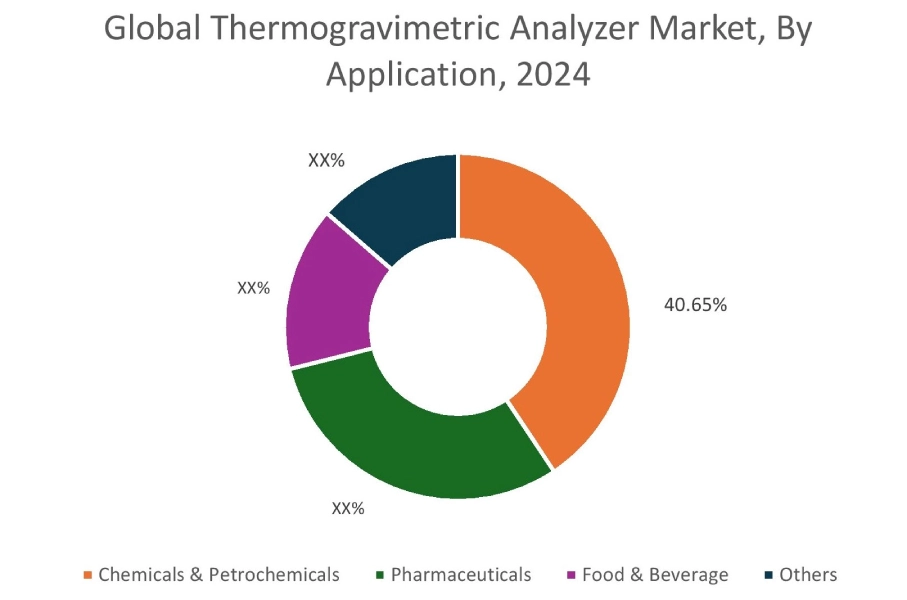
Regional Analysis:
The regions covered are North America, Europe, Asia Pacific, the Middle East and Africa, and Latin America.
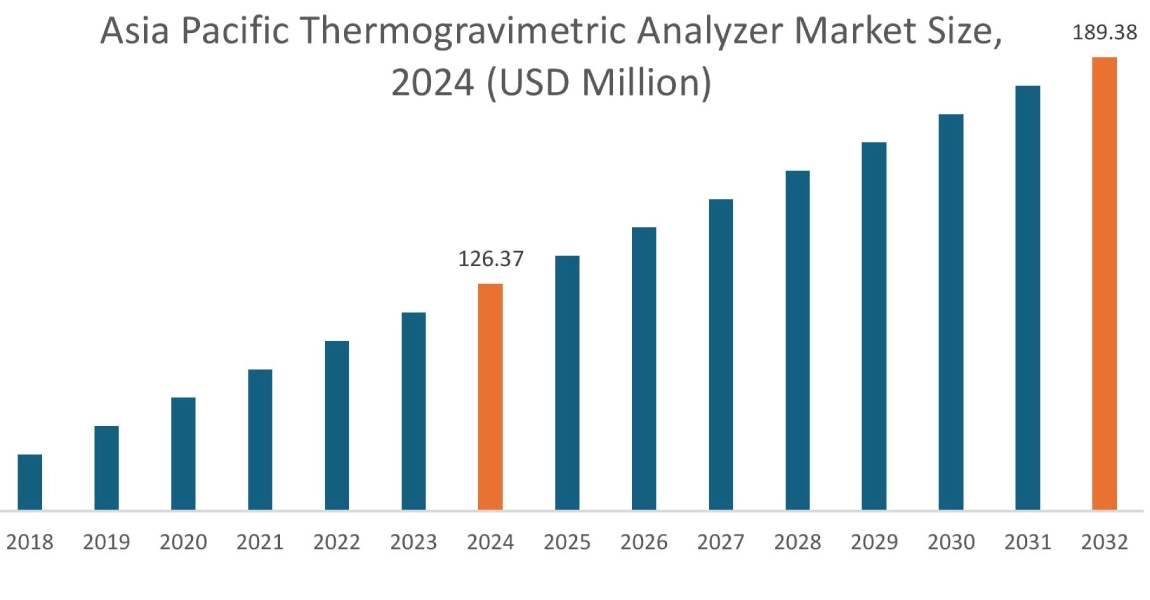
Asia Pacific region was valued at USD 126.37 Million in 2024. Moreover, it is projected to grow by USD 130.64 Million in 2025 and reach over USD 189.38 Million by 2032. Out of this, China accounted for the maximum revenue share of 33.82%. As per the thermogravimetric analyzer market analysis, the adoption of thermogravimetric analyzing instruments in the Asia-Pacific region is primarily driven by the growing pharmaceutical and chemical sectors among others. Additionally, the rising adoption of thermogravimetric analyzing instruments during pharmaceutical production is further accelerating the thermogravimetric analyzer market expansion.
- For instance, according to the India Brand Equity Foundation, the local pharmaceutical sector in India consists of approximately 3,000 drug companies and 10,500 pharmaceutical manufacturing units. The above factors are further driving the market in the Asia-Pacific region.
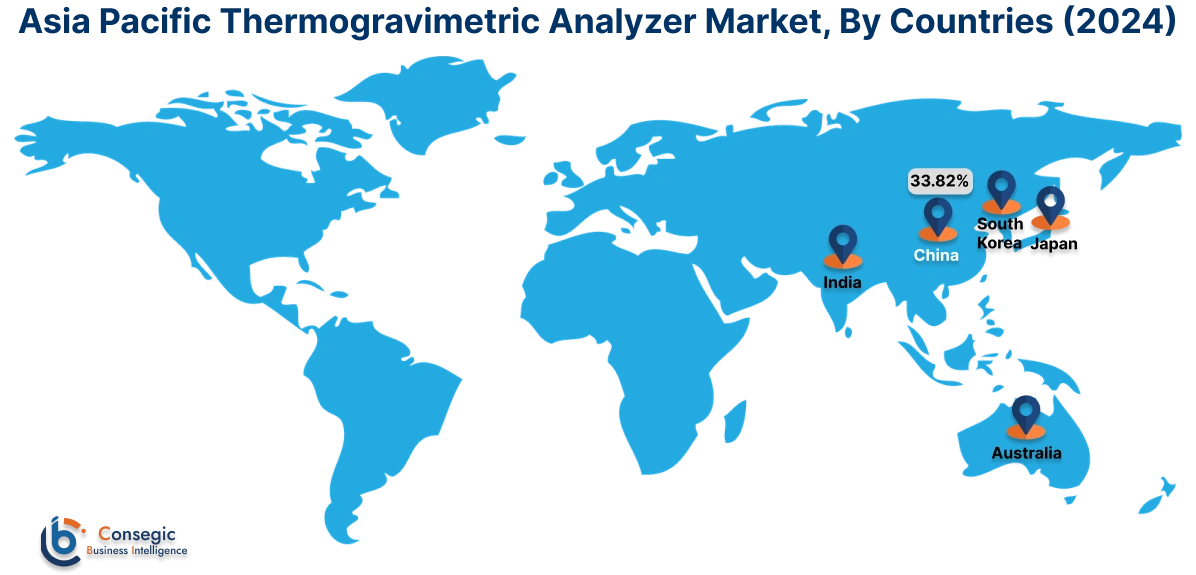
North America is estimated to reach over USD 226.24 Million by 2032 from a value of USD 157.09 Million in 2024 and is projected to grow by USD 161.85 Million in 2025. In North America, the growth of thermogravimetric analyzer industry is driven by the rising investments in food & beverage, chemical, and other sectors. Similarly, the increasing investments in development of chemical manufacturing facilities and rising utilization of thermogravimetry to determine the chemical characteristics are contributing to the thermogravimetric analyzer market demand.
- For instance, Kerry Group, a food and beverage company, announced the launch of its new food manufacturing facility in Georgia, United States in 2022. The food manufacturing facility was developed to meet the rising consumer demand in seafood, poultry, and alternative protein markets across the United States and Canada. The above factors are expected to propel the thermogravimetric analyzer market trends in North America during the forecast period.
Additionally, the regional analysis depicts that the growing chemical sector, rising pharmaceutical production, and significant investments in food & beverage manufacturing are driving the thermogravimetric analyzer market demand in Europe. Furthermore, as per the market analysis, the market demand in Latin America, Middle East, and African regions is expected to grow at a considerable rate due to factors such as rising pace of industrialization and increasing adoption of thermogravimetric analyzing solutions in food & beverage, pharmaceuticals, and chemical sectors among others.
Top Key Players and Market Share Insights:
The global thermogravimetric analyzer market is highly competitive with major players providing products to the national and international markets. Key players are adopting several strategies in research and development (R&D), product innovation, and end-user launches to hold a strong position in the thermogravimetric analyzer market. Key players in the thermogravimetric analyzer industry include-
- TA Instruments (USA)
- PerkinElmer (USA)
- Linseis (Germany)
- Setaram Instrumentation (France)
- Thermo Fisher Scientific (USA)
- LECO Corporation (USA)
- Mettler Toledo (USA)
- Shimadzu Corporation (Japan)
- Hitachi High-Tech Science Corporation (Japan)
- Rigaku Corporation (Japan)
- NETZSCH-Gerätebau GmbH (Germany)
Recent Industry Developments :
Product Launch:
- In January 2025, TA Instruments announced the launch of its new TGA smart-seal pans, which is a self-opening sample container that is primarily designed to facilitate the examination of atmosphere-sensitive samples in the company’s Discovery series thermogravimetric analyzers.
Thermogravimetric Analyzer Market Report Insights :
| Report Attributes | Report Details |
| Study Timeline | 2019-2032 |
| Market Size in 2032 | USD 667.76 Million |
| CAGR (2025-2032) | 4.3% |
| By Thermogravimetry Type |
|
| By Sales Channel |
|
| By Application |
|
| By Region |
|
| Key Players |
|
| North America | U.S. Canada Mexico |
| Europe | U.K. Germany France Spain Italy Russia Benelux Rest of Europe |
| APAC | China South Korea Japan India Australia ASEAN Rest of Asia-Pacific |
| Middle East and Africa | GCC Turkey South Africa Rest of MEA |
| LATAM | Brazil Argentina Chile Rest of LATAM |
| Report Coverage |
|
Key Questions Answered in the Report
How big is the thermogravimetric analyzer market? +
The thermogravimetric analyzer market was valued at USD 462.17 Million in 2024 and is projected to grow to USD 667.76 Million by 2032.
Which is the fastest-growing region in the thermogravimetric analyzer market? +
Asia-Pacific is the region experiencing the most rapid growth in the thermogravimetric analyzer market.
What specific segmentation details are covered in the thermogravimetric analyzer report? +
The thermogravimetric analyzer report includes specific segmentation details for thermogravimetry type, sales channel, application, and region.
Who are the major players in the thermogravimetric analyzer market? +
The key participants in the thermogravimetric analyzer market are TA Instruments (USA), PerkinElmer (USA), Mettler Toledo (USA), Shimadzu Corporation (Japan), Hitachi High-Tech Science Corporation (Japan), Rigaku Corporation (Japan), NETZSCH-Gerätebau GmbH (Germany), Linseis (Germany), Setaram Instrumentation (France), Thermo Fisher Scientific (USA), LECO Corporation (USA), and others.
